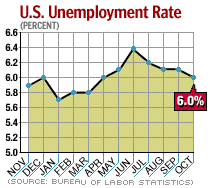NEW YORK (CNN/Money) -
With all the scary headlines about U.S. workers being replaced by machines and cheap overseas labor, one might get the impression that the labor market is now as good as it's ever going to get.
Most economists, however, believe it's still got plenty of room for improvement, though its recovery could continue to be agonizingly slow.
"We are still seeing some slack in the labor market, in several different places," said former Federal Reserve economist Lara Rhame, now a senior economist with Brown Brothers Harriman, echoing the sentiment of some Fed policy makers.

Rhame and many other economists believe unemployment, which is now at 6 percent, could go as low as 5 percent without causing wages to grow too fast, putting upward pressure on inflation and forcing the Fed to raise interest rates. Until that happens, the labor market will feel weaker than in most recoveries.
Still, a little perspective is in order: The worst unemployment ever got after the latest economic downturn was 6.4 percent. In comparison, unemployment surged to 7.8 percent after the 1990-91 recession and 10.8 percent after the 1981-82 recession.
And anybody waiting for unemployment to drop back to the 3.8 percent rate it reached in 2000 had better have a good book to read; they'll be waiting quite a while. Perhaps Dow 36,000 would be appropriate. Or Dow 100,000.
For more perspective, remember that, for a long time, 6 percent unemployment was considered an optimal level. Even if the optimal level is a little lower now, how bad can 6 percent unemployment be?
"What's most important is that we've got demand and supply moving ahead fast enough that we're absorbing and creating jobs month in and month out -- that's not something to lament," said Citigroup senior economist Steven Wieting.
Signs of slack
So should we just stop our whining and accept the status quo?
Well, not exactly.
"I think we can do better," said Wieting, who estimates the "natural" unemployment rate could be as low as 4.5 percent.
And in many ways, the labor market is worse than the unemployment rate would indicate. One negative figure from the Labor Department's mostly positive report on October unemployment was the abysmal 66.1 percent labor-force participation rate, the lowest level since April 1993.
| Related stories
|

|
|
|
|
What that means is that, even as some people re-entered the labor force to start looking for a job, an even greater number retreated to the sofa to wait for things to get better. When those people start pounding the pavement again, the official unemployment rate could rise.
What's more, in September and October, more than 23 percent of the nation's 8.8 million unemployed had been out of work for 27 weeks or more. There haven't been two straight months at such a high level since late 1983.
Meanwhile, the average workweek, according to the Labor Department, is just 33.8 hours long -- the same as it was in October 2002 and in September 2001. Many economists think businesses will start lengthening the workweek before they start hiring workers in big numbers.
Most importantly, however, wage growth has continued to decelerate. Growing wages are critical to the future of consumer spending, which makes up more than two-thirds of the total economy.
In October, average hourly earnings grew just 0.1 percent, according to the Labor Department. In the past three months, the annualized growth rate has slowed to just 0.8 percent, the slowest pace ever.
"If full employment is 6 percent, we wouldn't have seen wages decelerate," said Jim O'Sullivan, senior economist at UBS Warburg. "If anything, we would be seeing an acceleration."
The bogeymen: productivity, offshore competition
But we might not get to that stage until at least 2005, thanks in part to the twin bogeymen of productivity and offshore outsourcing.
Productivity, a measure of output per worker hour, has been growing like gangbusters thanks to new technology; it grew in 2002 at the fastest rate since Harry Truman was president, and it was even stronger in the third quarter. Though many economists expect it to cool off, it's still got a ways to go.
"We've reached the point where employers need to start hiring again, but productivity growth will stay strong, so they can meet some of their increased demand with productivity improvements," said Gus Faucher, senior economist at Economy.com. "That means hiring will be slow and the unemployment rate will stay at about 6 percent for another year and a half or so."
And it's no mystery that businesses are shipping more and more jobs overseas, including the formerly high-paying white-collar types, such as information technology. This is nothing new, and many economists doubt it will mean the end of employment in this country; eventually, it should help make even better jobs available here.
But, combined with productivity growth, offshore labor could help make employment growth torturously slow in the near term, especially in those industries with competition overseas.
"It's the 'Red Queen effect' -- you've got to run twice as fast just to stay in place," said Lakshman Achuthan, managing director of the Economic Cycle Research Institute.

|

